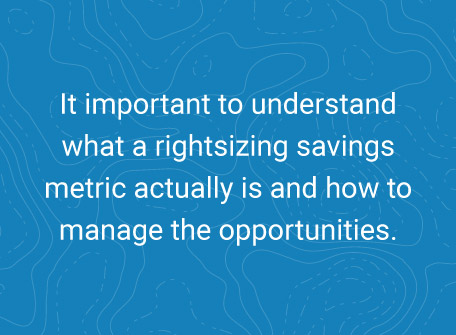
What are Rightsizing Metrics and How Should You Manage Them?
 Cloud Service Providers’ native tools and Cloud Management solutions like Cloudabilty, Cloud Health, Turbonomics, and more, all calculate a metric called “Rightsizing Savings”. For many companies using these Cloud tools, these rightsizing savings suggest ways the organization can save hundreds of thousands of dollars. But the truth is these numbers are misleading. It important to understand what a rightsizing savings metric actually is and how to manage the opportunities.
Cloud Service Providers’ native tools and Cloud Management solutions like Cloudabilty, Cloud Health, Turbonomics, and more, all calculate a metric called “Rightsizing Savings”. For many companies using these Cloud tools, these rightsizing savings suggest ways the organization can save hundreds of thousands of dollars. But the truth is these numbers are misleading. It important to understand what a rightsizing savings metric actually is and how to manage the opportunities.
By truly understanding what Rightsizing Savings metrics mean, teams will be able to identify next steps, manage expectations, and accurately forecast what’s possible with rightsizing savings. In this article, you’ll discover what Rightsizing Savings actually are and steps you can take to get more accurate projections for savings opportunities.
What is Rightsizing and Rightsizing Savings?
 Rightsizing is a retrospective on how resources were used. Every resource, container, and auto-scaling group are provisioned with computing, storage, etc. capabilities. Cloud Management tools are measuring how much of those capabilities are being used in the past days and seeing if a cheaper option could have done the same job. The difference in the price of using one type of resource vs. another cheaper option is the “rightsizing savings”.
Rightsizing is a retrospective on how resources were used. Every resource, container, and auto-scaling group are provisioned with computing, storage, etc. capabilities. Cloud Management tools are measuring how much of those capabilities are being used in the past days and seeing if a cheaper option could have done the same job. The difference in the price of using one type of resource vs. another cheaper option is the “rightsizing savings”.
For a non-technical example, let’s think about a moving truck. Moving trucks have a limited capacity of how much can be moved in the back of a truck. There are various sizes and prices associated with different rental trucks. In this example, rightsizing would be measuring how full the truck was over the rental period and calculating if the job could have been completed with a cheaper option. That way, if more jobs like this arise, the business can save money by using the cheaper alternative.
In theory this is very helpful, but rightsizing savings metrics are misleading in two ways. There are assumptions made with these metrics that skew the reality of what can be saved. As an aggregate figure it obfuscates what truly can be rightsized.
Rightsizing Savings Assumptions
Here are assumptions that are made when Rightsizing Savings are calculated:
Resources will be used the same way in the future
Various products have increases and decreases in usage over time. We need to remember that even if a resource wasn’t fully used yesterday, it still could be used fully tomorrow. Cloud Management tools do not have this context and will report opportunities that would be bad to execute.
Overprovisioning wasn’t intentional
There are valid business reasons to overprovision resources. Cloud Management tools don’t know what those reasons are. For example, failover servers will always be marked with large savings opportunities since they aren’t being used, even though they are critical for businesses to keep.
The discounted rate
Rightsizing Savings are often over inflated because they usually don’t account for reservations being used and enterprise discounts. What’s reported as $50,000 in savings would be far less when discounts are considered.
Rightsizing Savings Aggregations
Rightsizing metrics are displayed as aggregates too. They are a summation of all identified opportunities. The issue is that this aggregation of savings can encapsulate many opportunities that would cost more to implement than they would actually save.
Many Cloud Management tools may identify opportunities to save $1. Out of a $50,000 projection, the key would be to see how many opportunities would save more than $1, $2, $20, or even $100. Another important consideration is that every rightsizing opportunity takes time to execute. Is 20 minutes of a developer’s time worth $2 a month of rightsizing savings? Are the automation tools being used costing more than the savings being generated? The point is, that out of the aggregate value, the true opportunities of rightsizing will be a subset of that amount.
How to Manage Rightsizing Savings Opportunities
Now that you have a better understanding of some of the limitations of rightsizing savings, let explore how to manage them more effectively in Cloud Management tools, so that you spot true opportunities.
Add the Discount Rate
Adding the discount rate helps identify a more accurate estimate for the Rightsizing Savings identified and temper unrealistic saving goals.
Filter Out the Opportunities with Low Savings
The FinOps team should work with key stakeholders to determine what the minimum threshold should be regarding these savings. Typically, large organizations filter out opportunities that are less than $100 a month in savings. For smaller organizations, a lower threshold may be more appropriate.
Organize by Service and Reservation
Not every service will have rightsizing opportunities, and some services are covered by reservations. It’s important to not rightsize out of a reservation. Organizations are stuck with fulfilling a reservation and it will, in most cases, increase the overall cost of using resources by underutilizing the reservation.
Organize Resources by What They are Being Used For
Resources in development environments are safer to rightsize compared to production environments. Similarly, some products and services being provided through the Cloud are more important than others. By categorizing how resources are being used, FinOps teams will be able to identify business areas that are better to rightsize versus critical business areas where rightsizing is too risky.
When Executing an Opportunity, Write the Results
Any underutilized resource will appear every time rightsizing savings opportunities are generated. Tracking the results of what was determined in rightsizing or not rightsizing a resource will help track actualized savings and exclude resources that are not good candidates for rightsizing.
It’s important to remember that Rightsizing Savings metrics can be useful, but are often misleading. Knowing how to evaluate your rightsizing savings more accurately by using the steps above with help you manage your stakeholders’ expectations and allow you to find and execute on true opportunities.
Rego Can Help
Need more help making sense of your rightsizing savings data or scaling FinOps in your organization? Contact us for a no-pressure conversation. We’re happy to help.
We’ve guided more than 650 organizations through their FinOps, TBM, PPM, and Agile journeys, including 60% of Fortune 100 companies.











